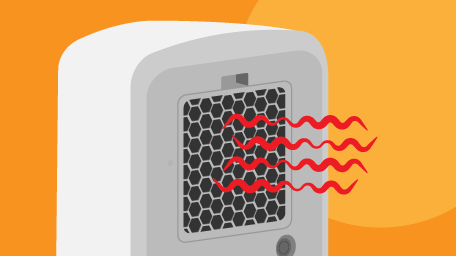

How to Clean and Replace Your Oven Racks
Find out the best ways to clean your oven racks!
Cleaning your oven racks, which can accumulate grease and grime over time, is crucial to minimizing fire risks and enhancing your oven’s smell and appearance. This guide will navigate you through the three best cleaning methods for your oven racks, which include using soap and water, a spray cleaner, and a combination of baking soda and vinegar. These methods are proven and effective, but you can choose whichever is most convenient for you. We’ll also address common questions about oven racks, to help you better understand this cleaning process, and to help you get your racks shiny again!
Why and How Often You Need to Clean Your Oven Racks
Oven racks are removable metal shelves installed within your oven that support food items, containers, and trays, so they have a supporting platform to cook and bake on. Your oven racks will eventually get covered with grime and grease, and either need to be cleaned, or replaced. Neglecting to clean your oven racks will result in food residue buildup that can increase a fire risk, and create hard-to-remove odors. That is why we recommend cleaning your oven racks with this guide at least once or twice a year, or more frequently, based on your oven usage. This will help maintain their condition, prevent replacement, and enhance your comfort.
Best Ways to Clean Oven Racks
Cleaning your oven racks is easy and can be done quickly and effectively, whether they’re only slightly grimy, or heavily greased. The best methods for cleaning oven racks are either in a bathtub or large container, or outside in a large plastic bag. These options minimize mess and hassle compared to using a sink, but a sink can also be used if a tub or outdoor cleaning option doesn’t suit your set-up. Regardless of whichever cleaning process suits you better, we have the guides to assist you.
How to Clean Oven Racks in a Bathtub
The most common recommendation from experts is cleaning oven racks in the bathtub, as it allows for ample space and water to thoroughly clean them, without all the mess. But if you do not have access to a bathtub, a large container can serve as an effective alternative for cleaning your oven racks. We have a list of all the supplies you’ll need, along with instructions to explain how to make sure they’re effectively cleaned.
Everything You Need:
- Bathtub or Large Container
- Warm Water
- Dish Soap/Detergent or Dishwasher Tablet
- Towels
- Non-Abrasive Sponge or Brush
Step-by-Step Guide:
- If you’re using a bathtub, spread towels at the bottom of the tub to ensure it doesn’t get scratched by the racks.
- Place your oven racks inside the bathtub or large container.
- Fill the bathtub or large container with warm water and pour dish soap/detergent or place a dishwasher tablet in the water.
- Agitate the water to ensure the soap or tablet dissolves properly.
- Leave the racks to sit in the soap and water for a few hours, or overnight if possible.
- Once the racks have soaked for that extended period of time, drain the water from the tub or container.
- Rinse the racks with warm, clean water, and scrub them with a sponge or brush.
How to Clean Oven Racks in Plastic Bags
Using a large plastic bag to clean your oven racks offers a convenient and efficient way to clean your oven racks. By using plastic bags and a spray aerosol cleaner, you save water, avoid a messy cleanup, and still get clean oven racks. The plastic bags are used to help seal the cleaner to the oven racks and ensure it stays wet for a longer period, which improves its cleaning power and prevents it from dripping off. We’ll provide you with a comprehensive list of the supplies you’ll need, and step-by-step instructions to make it as easy and hassle-free as possible.
Everything You Need:
- Trash Bag(s)
- Non-Abrasive Sponge or Soft-Bristle Brush
- Latex/Rubber Gloves
- Spray/Aerosol Cleaning Product of Choice (Easy-Off, for example)
- Clean Water
- Dish Soap
Step-by-Step Guide:
- Make sure you are outside your home, and in a well-ventilated area.
- Put the oven racks in their own respective bag.
- Spray each rack liberally with a specialized oven cleaning product of your choice.
- Ensure each rack is completely covered, and then close the bags and allow them to sit for 30 minutes to an hour, flipping them over halfway through.
- After the hour is up, remove the oven racks and scrub them with a non-abrasive sponge or brush, and then wash the grease and gunk off with clean, soapy, warm water.
How to Use Baking Soda and Vinegar to Clean Oven Racks
If you want to clean your oven racks using all-natural ingredients and without the harsh chemicals and fumes of some spray cleaners, you can use the more natural solution of baking soda and vinegar to help break it down. Using a baking soda and vinegar combination together can act as a mild abrasive and acid, which makes cleaning tough grime and grease stains with a sponge or brush easier. Below, we’ll detail everything you need, and all the required steps to get the rest of the mess off.
Everything You Need:
- Bathtub or Large Container
- Baking Soda
- Vinegar
- Bowl
- Paint Brush (or something similar)
- Non-Abrasive Sponge or Brush
- Warm Water
- Spray Bottle (Optional)
- Towels (Optional)
Step-by-Step Guide:
- If you’re using your bathtub, ensure you place towels down before you put your oven racks down.
- Place your oven racks in a large container or bathtub.
- Create a paste with equal parts baking soda and water (a half cup of each will work) in a bowl.
- Use a brush to coat the racks with the paste, and allow it to sit for 30-45 minutes.
- After that time, create a mixture of equal parts vinegar and water, and spray or slowly pour it over the racks.
- Allow the racks to sit for another 30 minutes.
- After 30 minutes, rinse the racks with clean water, and then scrub them with a soft brush or non-abrasive sponge and warm, soapy water.
- Rinse the racks a final time, and allow them to dry.





